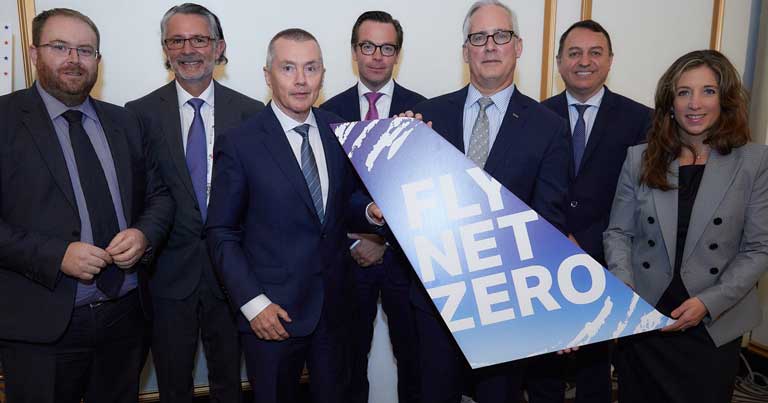
The global air transport industry has committed to reaching net zero carbon emissions by 2050, during the International Air Transport Association (IATA) 77th Annual General Meeting.
Willie Walsh, IATA’s Director General, said: “The world’s airlines have taken a momentous decision to ensure that flying is sustainable. The post-COVID-19 re-connect will be on a clear path towards net zero. That will ensure the freedom of future generations to sustainably explore, learn, trade, build markets, appreciate cultures and connect with people the world over. With the collective efforts of the entire value chain and supportive government policies, aviation will achieve net zero emissions by 2050.”
Achieving net zero emissions will be a huge challenge, admits IATA. The aviation industry must progressively reduce its emissions while accommodating the growing demand of a world that is eager to fly.
IATA states that to be able to serve the needs of the ten billion people expected to fly in 2050, at least 1.8 gigatons of carbon must be abated in that year. Moreover, the net zero commitment implies that a cumulative total of 21.2 gigatons of carbon will be reduced between now and 2050.
A key immediate enabler is the International Civil Aviation Organization’s (ICAO) Carbon Offsetting and Reduction Scheme for International Aviation (CORSIA). This is expected to stabilise international emissions at 2019 levels in the short-to-medium term.
Industry-wide collective effort
IATA also stressed that the path from stabilising emissions to emissions reductions will require a collective effort. All industry stakeholders, including governments must each individually take responsibility to address the environmental impact of their policies, products, and activities. And they must work together to deliver sustainable connectivity and ultimately break “aviation’s dependence on fossil fuels”.
“Achieving sustainable global connectivity cannot be accomplished on the backs of airlines alone. All parts of the aviation industry must work together within a supportive government policy framework to deliver the massive changes that are needed, including an energy transition. That is no different than what we are seeing in other industries. Road transport sustainability efforts, for example, are not being advanced by drivers building electric vehicles. Governments are providing policies and financial incentives for infrastructure providers, manufacturers and car owners to be able to collectively make the changes needed for a sustainable future. The same should apply to aviation,” said Walsh.
Roadmap
IATA has highlighted a roadmap, which includes reducing CO2 emissions from in-sector solutions such as sustainable aviation fuels, new aircraft technology, more efficient operations and infrastructure, and the development of new zero-emissions energy sources such as electric and hydrogen power. Any emissions that cannot be eliminated at source will be eliminated through out-of-sector options such as carbon capture and storage and credible offsetting schemes.
“We have a plan. The scale of the industry in 2050 will require the mitigation of 1.8 gigatons of carbon. A potential scenario is that 65% of this will be abated through sustainable aviation fuels. We would expect new propulsion technology, such as hydrogen, to take care of another 13%. And efficiency improvements will account for a further 3%. The remainder could be dealt with through carbon capture and storage (11%) and offsets (8%). The actual split, and the trajectory to get there, will depend on what solutions are the most cost-effective at any particular time. Whatever the ultimate path to net zero will be, it is absolutely true that the only way to get there will be with the value chain and governments playing their role,” added Walsh.
The new resolution demands that all industry stakeholders commit to addressing the environmental impact of their policies, products, and activities with concrete actions and clear timelines, including:
- Fuel-producing companies bringing large scale, cost-competitive sustainable aviation fuels (SAF) to the market.
- Governments and air navigation service providers (ANSPs) eliminating inefficiencies in air traffic management and airspace infrastructure.
- Aircraft and engine manufacturers producing radically more efficient airframe and propulsion technologies.
- Airport operators providing the needed infrastructure to supply SAF, at cost, and in a cost-effective manner.
IATA also urged governments to take active role in establishing holistic government policy framework focused on realising cost-effective solutions. This is particularly true in the area of SAF, for instance, technology exists, but production incentives are needed to increase supply and lower costs.
The resolution also calls on governments through ICAO to agree a long-term goal equivalent to the industry’s net zero by 2050 commitment, and to support CORSIA, coordinate policy measures and avoid a patchwork of regional, national, or local measures.
Timeframe
The combination of measures needed to achieve net zero emissions for aviation by 2050 will evolve over the course of the commitment based on the most cost-efficient technology available at any particular point in time. A base case scenario as follows is the current focus:
- 2025: With appropriate government policy support, SAF production is expected to reach 7.9 billion litres (2% of total fuel requirement)
- 2030: SAF production is 23 billion litres (5.2% of total fuel requirement). ANSPs have fully implemented the ICAO Aviation System Block Upgrades and regional programs such as the Single European Sky
- 2035: SAF production is 91 billion litres (17% of total fuel requirement). Electric and/or hydrogen aircraft for the regional market (50-100 seats, 30-90 min flights) become available
- 2040: SAF production is 229 billion litres (39% of total fuel requirement). Hydrogen aircraft for the short-haul market (100-150 seats, 45-120 min flights) become available.
- 2045: SAF production is 346 billion litres (54% of total fuel requirement).
- 2050: SAF production hits 449 billion litres (65% of total fuel requirement).
“Sustainability is the challenge of our generation. And today we are launching a transition that is challenging. But in 30 years it is also within reach of human ingenuity, provided governments and the whole industry work together and hold each other accountable for delivery,” he concluded.





